Source: Glassnode; Compiled by: Baishui, Golden Finance
Summary
Since hitting a cyclical low in November 2022, Bitcoin's dominance has continued to climb, and now accounts for 56% of the total cryptocurrency market value.
Despite volatile price fluctuations, the conviction of long-term holders remains unwavering, and they have a clear tendency to accumulate and hold tokens.
During the recent downturn, short-term holders have borne most of the losses. However, the extent of locked-in losses suggests that they may have overreacted to the event.
Market Overview
Since hitting a cyclical low in November 2022, capital has continued to accumulate toward the main asset end of the digital asset risk curve. The dominant position of Bitcoin has risen from 38%in November 2022 to 56%of the entire digital asset market today. It has maintained relatively stable in the past two years.
Bitcoin dominance: 38.7% (November 2022) —> 56.2% (current) (red)
Ethereum dominance 16.8% —> 15.2% (blue)
Stablecoin dominance 17.3% —> 7.4% (green)
Altcoin dominance 27.2% —> 21.3% (purple)
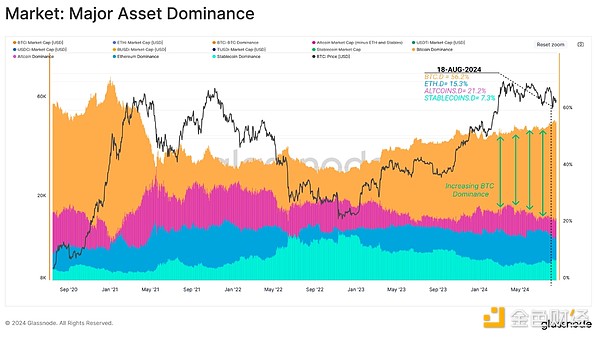
However, when we evaluate the changes in the net capital of major assets, Bitcoin, Ethereum and Stable Coins have shown net capital inflows.
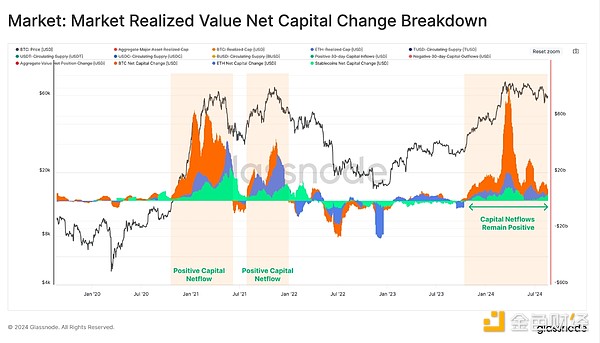
Next, we can utilize the major asset buyer vs seller indicator, which aims to identify the shift of capital based on the preference of exchange inflows. This can be thought of under the following framework:
Values close to zero indicate the existence of a neutral regime, where buyer inflows are the same as BTC+ETH seller inflows.
Positive values indicate the existence of a net buyer regime, where buyer inflows of stablecoins exceed seller inflows of BTC+ETH. (Green)
Negative values indicate a net seller mechanism, where stablecoin buy-side inflows are smaller than BTC+ETH sell-side inflows. (Red)
Since setting a new ATH in March 2024, sell-side pressure has receded and is currently recording its first positive data point since June 2023 ($91.8m/day).
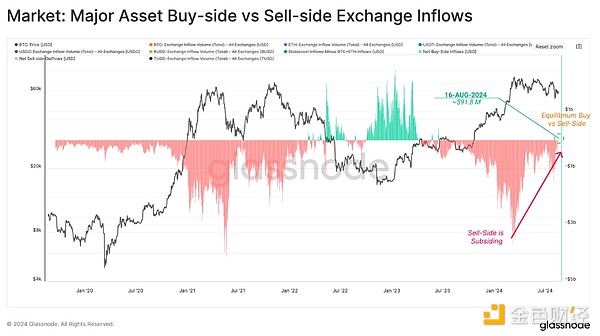
Long-term holders
Long-term holders have locked in steady profits of $138m per day in the recent volatile market environment. Each trade matches buyers and sellers, resolving the supply and demand imbalance through price changes.
Thus, we can infer that the pressure of about $138 million per day from LTH sellers indicates the need to absorb supply and keep prices stable in order to receive daily capital inflows. While market conditions have been volatile, prices have generally been flat over the past few months, suggesting that some kind of balance is being reached.

The actual profit/loss ratio of long-term holders is an indicator we can use to assess the cyclical behavior of this group. We note that although the indicator has dropped significantly from its peak, it is still at a high level. This suggests that long-term investors are cooling down their profit-taking activities.
It is noteworthy that during the March 2024 ATH, the metric reached a similar height to the previous market high. In both the 2013 and 2021 cycles, the metric declined to similar levels before resuming the price uptrend. However, in 2017-18, the decline was one-way as the market entered a loss-led bear market.
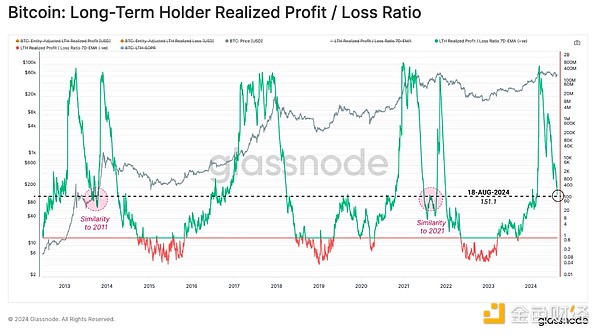
From the perspective of the long-term holder SOPR, we can see that the average profit rate of tokens locked is +75%, and LTH-SOPR is still high at this time.
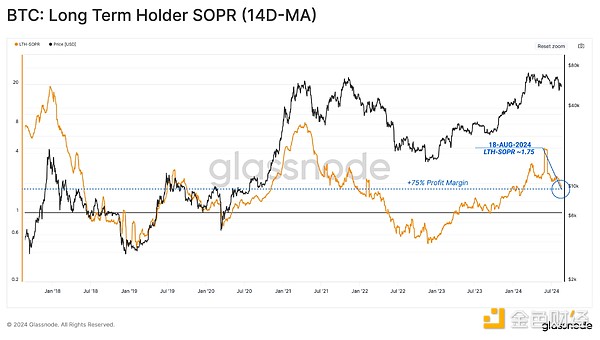
Using our LTH binary spending indicator, the above slowdown in spending by long-term holders can be seen.
LTH supply is currently increasing rapidly. When we consider that the 155-day threshold of LTH status is close to the March ATH, this shows that the supply acquired during the ATH run-up remains in a holding state. This highlights that holding behavior clearly exceeds spending behavior.
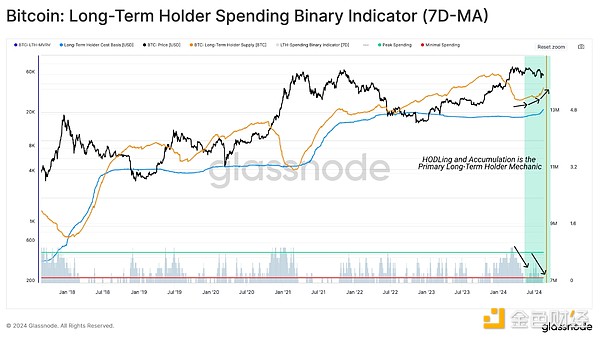
Psychological Relevance
Turning to the opposite group, the short-term holders, we can measure the intensity of the unrealized financial pressure experienced by recent buyers. We can observe this dynamic using the STH-MVRV ratio indicator and apply a 30-day average.
STH-MVRV has recently contracted below its equilibrium value of 1.0, suggesting that the average new investor is now holding unrealized losses.
Brief periods of unrealized loss pressure are common during bull markets. However, periods where STH-MVRV is trading below 1.0 for a sustained period could lead to a higher probability of investor panic and signal a more severe bearish trend.
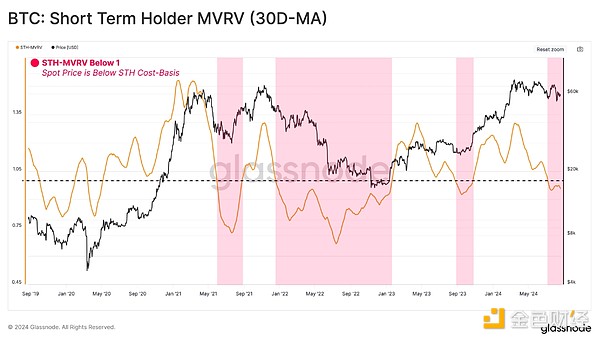
As unrealized losses grow, expectations grow that investors will eventually sell. Such events are characterized by locking in significant losses through spending tokens.
When STH-SOPR trades below 1.0, periods of high loss realization by new investors in the market can be seen.
From this perspective, we can also see that STH-SOPR is trading below 1.0, indicating a certain level of loss realization activity by new investors. This further suggests that the market is at a decision point, with prices just below STH's comfort point.
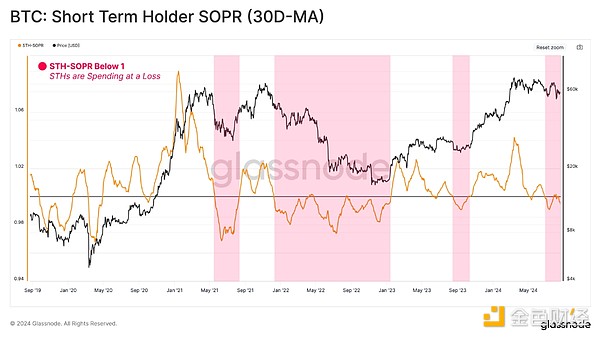
Despite the correlation between unrealized and realized activity, new investors may overreact to relatively high unrealized profits (or losses) held in their portfolios. This overreaction is a key feature of the market, with investors' emotional reactions causing them to realize excessive profits (or losses) at inflection points, forming local and macro tops (or bottoms).
The chart below compares the expense cost basis of new investors who decided to trade with the average cost basis of all investors who are still holding. The deviation between these two indicators can provide insight into the extent of potential overreaction.
The bull market correction we have seen in our current cycle has only experienced a slight deviation between the expense and holding cost basis. From this, it can be argued that a modest overreaction may have occurred as the market fell below $50,000.
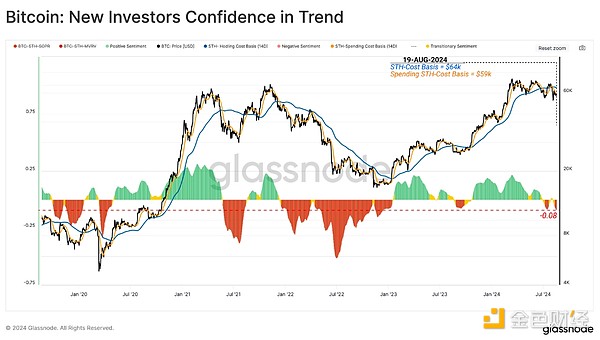
Navigating the Investor Cycle
In the previous section, we used the MVRV and SOPR metrics, which take into account the overall profit and loss profile of investors. This section will only analyze tokens that are held and traded at a loss.
By assessing the relative unrealized loss metric for new investors, we can directly measure the unrealized financial pressure borne by new investors.
Currently, the magnitude of unrealized losses relative to STH’s market cap remains relatively low compared to historical sell-off events. The magnitude of losses held by the market is arguably similar to previous bull market corrections.
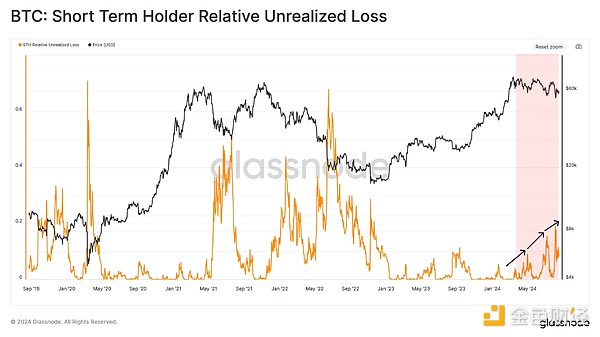
However, when we compare the accumulation of unrealized losses to the losses locked in tokens (realized losses), we can see that this correlation diverges. Realized losses are significantly higher, highlighting the modest overreaction we described above.

By evaluating STH's cumulative 90-day realized losses and average unrealized losses, we can visually highlight the convergence and correlation between the two metrics.
During cyclical price lows, the magnitude of realized and unrealized losses tend to spike between 10% and 60% of STH's total holdings. By this measure, the magnitude of unrealized and realized losses remains relatively small compared to prior major bottom formation events.
A constructive analogy is the similarity between the current structure and the 2016-2017 cycle, where the relative metrics depicted were below the consensus ceiling of approximately 10%.
From this, we can say that the blow to investor sentiment may not be as severe as it appears.
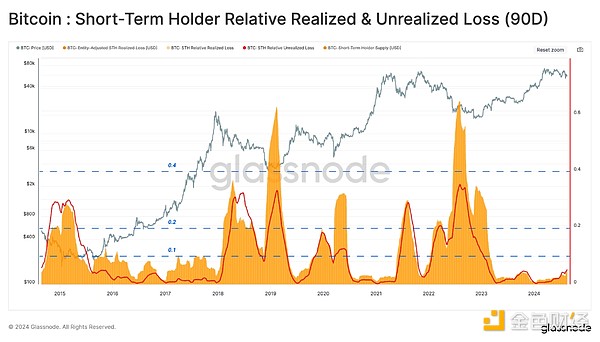
Summary
Due to widespread uncertainty among market investors, capital continues to flow along the risk curve, leading to a significant expansion of Bitcoin's dominance, with the leading asset currently accounting for 56% of the total market capitalization.
Although the price trend is turbulent, The determination of long -term holders is still firm, and they obviously tend to hold and purchase tokens. OLOR: RGB (0, 112, 192); "> Short -term holders have undertaken the vast majority of losses among the recent quotes. Despite this, The degree of locking the loss indicates that they may respond to this incident. Excess.
 JinseFinance
JinseFinance
 JinseFinance
JinseFinance JinseFinance
JinseFinance JinseFinance
JinseFinance JinseFinance
JinseFinance JinseFinance
JinseFinance JinseFinance
JinseFinance Edmund
Edmund Alex
Alex JinseFinance
JinseFinance Bitcoinist
Bitcoinist